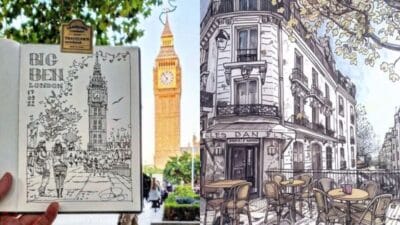
Ever felt stuck staring at a blank page, wondering where to even begin? Or perhaps you’re an experienced artist looking to inject some raw energy back into your practice? If so, then diving into the dynamic world of 30 second gesture drawing might just be the artistic spark you need. This isn’t about creating masterpieces; it’s about unlocking your creative flow, enhancing your observational skills, and building a powerful foundation for all your artistic endeavors.
Imagine capturing the very essence of a pose, the fleeting movement of a body, or the dynamic interplay of shapes and lines in less time than it takes to tie your shoe. Sound impossible? It’s not. 30 second gesture drawing is a high-octane exercise designed to bypass overthinking and tap directly into your intuition. It’s about feeling the form, understanding the rhythm, and letting your hand move with decisive, confident strokes. Forget perfection; embrace the power of imperfection and discover a freedom in your drawing you never knew you had.
What Exactly is 30 Second Gesture Drawing?
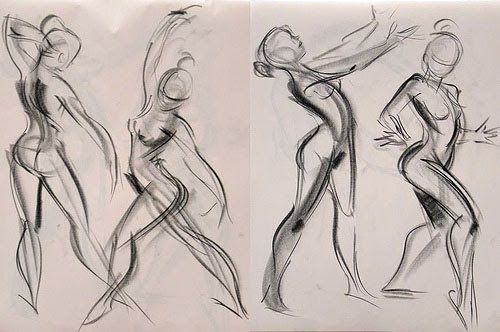
At its heart, gesture drawing is an exercise focused on capturing the primary movement, energy, and overall form of a subject, rather than its intricate details. When we talk about “30 second gesture drawing,” we’re taking that concept and cranking up the intensity to a whole new level. It’s a sprint, not a marathon, designed to force your brain to make quick decisions and your hand to act without hesitation.
Think of it as the ultimate artistic warm-up, or a powerful observational training tool. Instead of meticulously rendering a figure, you’re aiming to understand its “gesture” – the feeling of the pose, the direction of the movement, the push and pull of the body’s weight. In just half a minute, you’re tasked with identifying the core lines of action, the major masses, and how they connect to convey dynamic energy.
Historically, artists have used gesture drawing for centuries. Masters like Leonardo da Vinci and Michelangelo filled sketchbooks with rapid studies of the human form, capturing movement and anatomical understanding through quick, expressive lines. They weren’t trying to finish a portrait; they were dissecting the pose, understanding the mechanics, and building a visual vocabulary. In our modern context, with endless online resources providing timed references, it’s more accessible than ever to engage in this foundational practice. It’s not about making a “good” drawing in the traditional sense; it’s about making an effective drawing that communicates energy and form.
Why Bother with Such Short Timers? The Unseen Benefits
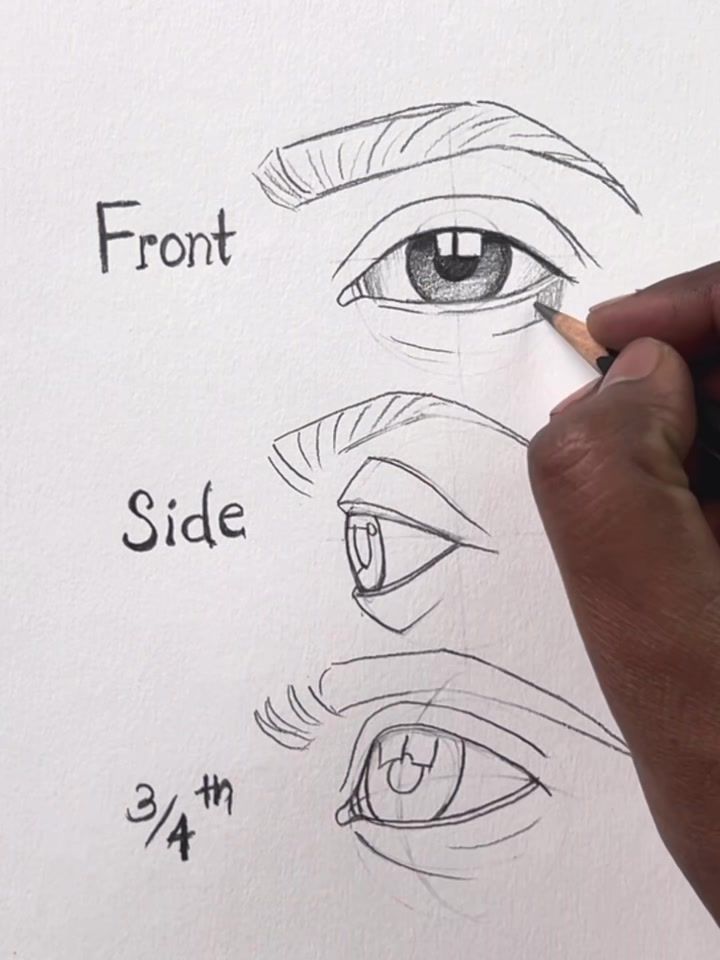
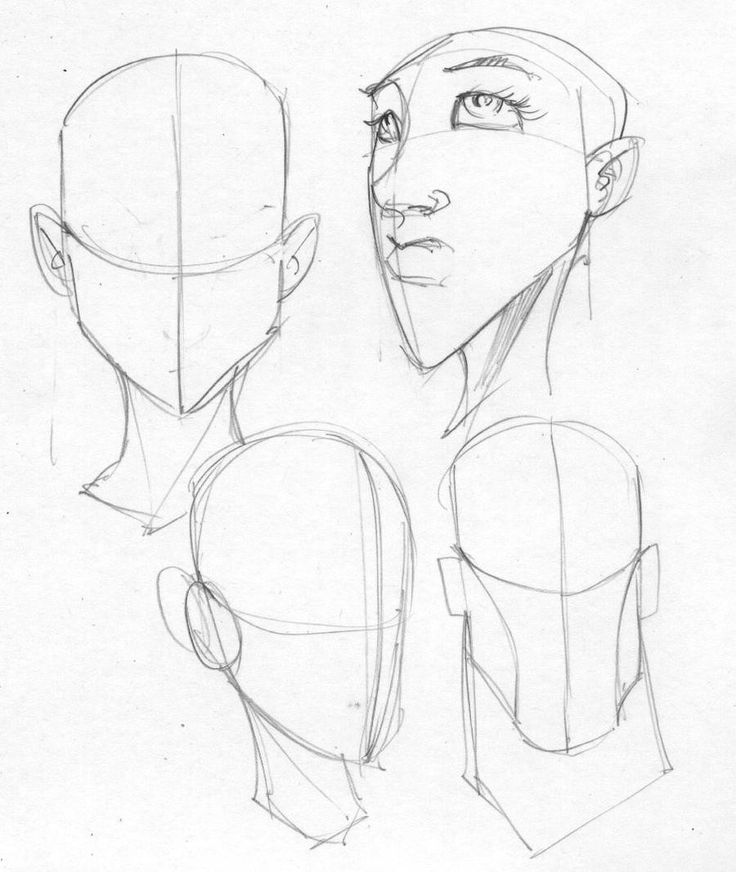
Thirty seconds might seem ridiculously short. What could you possibly accomplish in that blink of an eye? Turns out, quite a lot! The brevity of the timer is precisely what makes 30 second gesture drawing so incredibly potent for artists of all levels.
First off, it develops incredible speed and efficiency. You simply don’t have time to second-guess yourself, erase, or get bogged down in tiny details. This forces you to prioritize, to see the forest before the trees, and to make decisive marks. This speed translates directly into more fluid and confident drawing in all your other work.
Secondly, it dramatically improves your observation skills. When time is of the essence, your eyes learn to quickly scan a subject, identify the most crucial information—the line of action, the main masses, the overall rhythm—and ignore the rest. You train yourself to see the whole, rather than getting lost in individual features. This “big picture” thinking is invaluable for any kind of art.
Perhaps one of the most significant benefits is how it boosts confidence and reduces overthinking. Many artists, especially beginners, struggle with perfectionism. They want every line to be “right,” leading to stiffness and frustration. With 30-second gestures, there’s no time for perfectionism. You’re encouraged to embrace mistakes, to see each drawing as an experiment, and to celebrate the act of putting lines down. This freedom from self-criticism can be incredibly liberating and allows your innate artistic voice to shine through.
Moreover, gesture drawing enhances your understanding of form and anatomy in a dynamic way. While you’re not drawing every muscle, you’re constantly analyzing how the body twists, bends, stretches, and supports its weight. This active understanding of underlying structure, proportion, and balance becomes intuitive through repetition. You’ll start to feel the forms rather than just seeing them.
Finally, 30-second gestures are an excellent warm-up for longer drawing sessions. Just like an athlete stretches before a workout, these quick studies get your hand, eye, and mind in sync, preparing you for more detailed work. They also build a strong foundation for those longer drawings. Once you can quickly capture the essence of a pose, adding details becomes much easier because you’ve already established a solid, dynamic structure. It’s like having a fantastic blueprint before you start decorating a house.
Getting Started: Your Essential Toolkit (Minimalism is Key!)

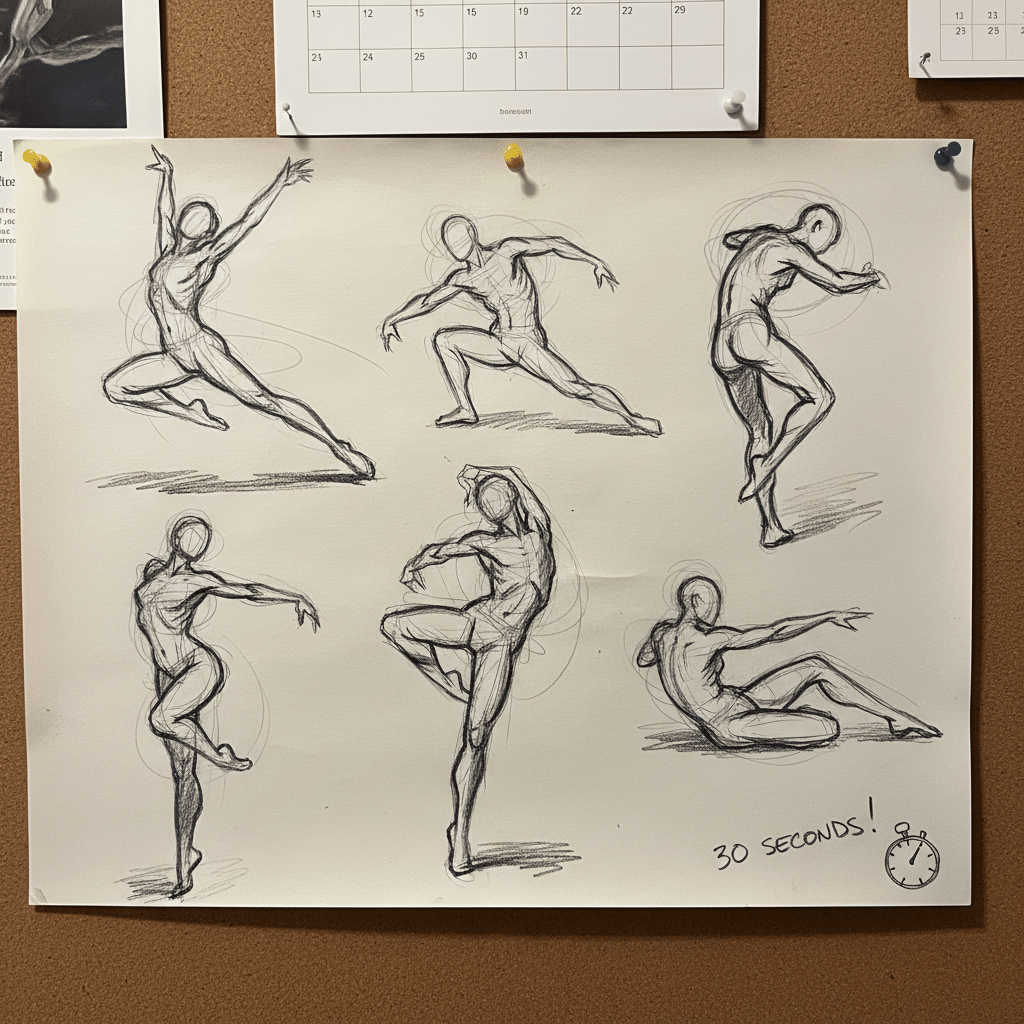
One of the beautiful things about 30 second gesture drawing is how little you need to get started. Forget expensive art supplies; the simpler, the better. The goal here is to remove any barriers to entry and keep the focus purely on the drawing process itself.
Your Minimalist Arsenal:
- Paper: Seriously, any paper will do. Newsprint is fantastic because it’s cheap, comes in large pads, and allows for broad, expressive marks. Printer paper, scrap paper, even the back of old envelopes – don’t be precious about it. The idea is to go through a lot of paper without guilt.
- Drawing Tools:
- Pencils: A simple charcoal pencil or a soft graphite pencil (like a 2B or 4B) is ideal. They glide smoothly and allow for a good range of line weights.
- Charcoal Sticks: Vine charcoal or compressed charcoal sticks are amazing for gesture drawing. They create beautiful, flowing lines and broad strokes quickly, emphasizing mass and movement.
- Pens: A felt-tip pen or even a ballpoint pen can work wonders, forcing you to commit to your lines. This can be challenging but incredibly rewarding.
Why simple tools? Because they don’t allow for fiddling or overworking. A soft charcoal stick encourages you to use your whole arm, making big, sweeping gestures instead of tight, hesitant scratches.
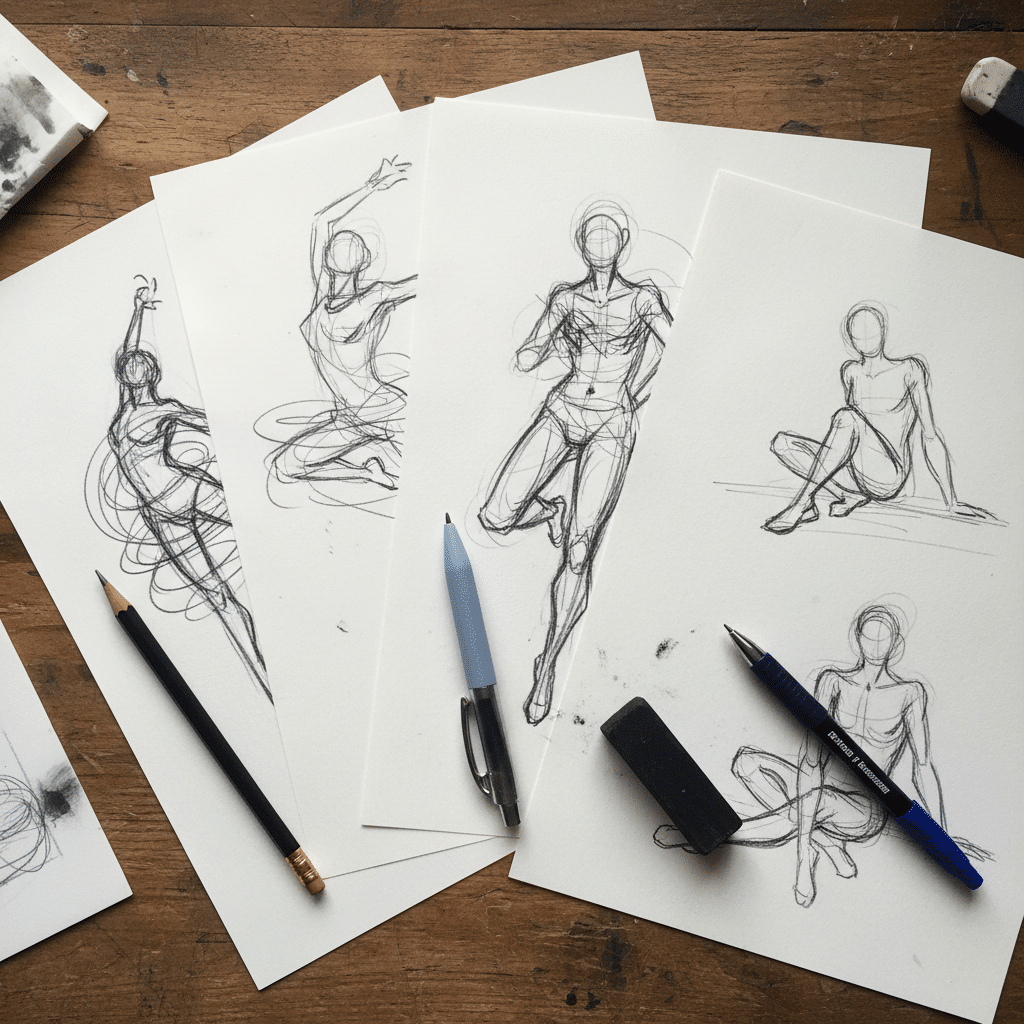
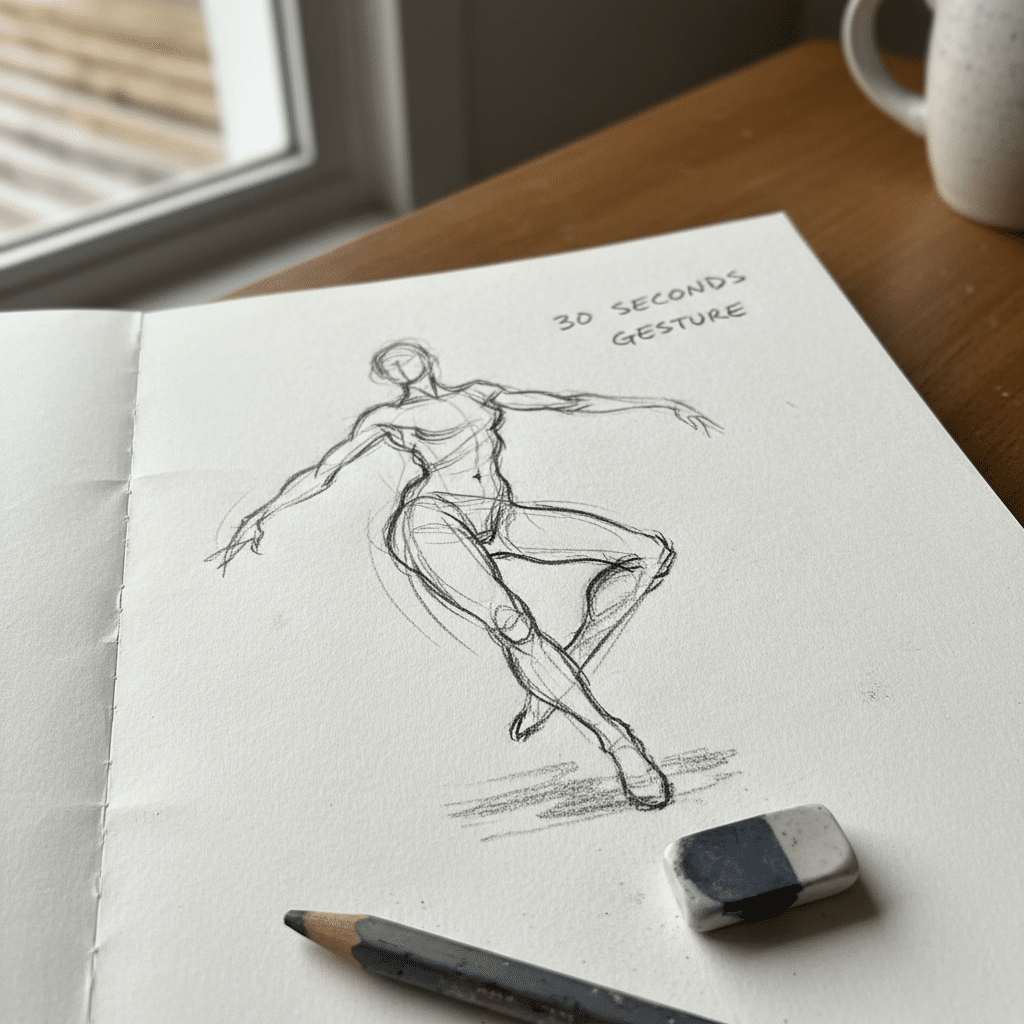
Finding Your References:
The easiest way to practice 30 second gesture drawing is with timed references. Thankfully, the internet is brimming with resources:
- Online Gesture Drawing Tools: Websites like Line of Action, Quickposes, or Croquis Cafe offer extensive libraries of model poses with customizable timers. You can select male, female, clothed, nude, animal, or even architectural poses, and set timers from 30 seconds all the way up to 10 minutes or more. These are perfect for focused practice.
- Live Models: If you’re lucky enough to have access to a local art studio or life drawing group, live models offer an unparalleled experience. The three-dimensionality and subtle shifts in a live pose are incredibly beneficial.
- Everyday Life: Once you get comfortable, challenge yourself to draw from life. People waiting at a bus stop, a child playing, a pet stretching, even the way a towel drapes over a chair – anything with form and potential movement can be a subject. Just be discreet and quick! For ideas on where to find broader inspiration, check out these top 10 sources of inspiration for designers and artists.
Setting Up Your Space:
Find a comfortable spot where you can stand or sit with good posture. Make sure your paper is easily accessible and your drawing tool is ready. You want minimal friction between you and the act of drawing. Some artists prefer to stand at an easel or against a wall, allowing for bigger, more expressive arm movements. Others are perfectly happy at a desk. The key is comfort and freedom of movement.
The Core Principles of a Killer 30-Second Gesture

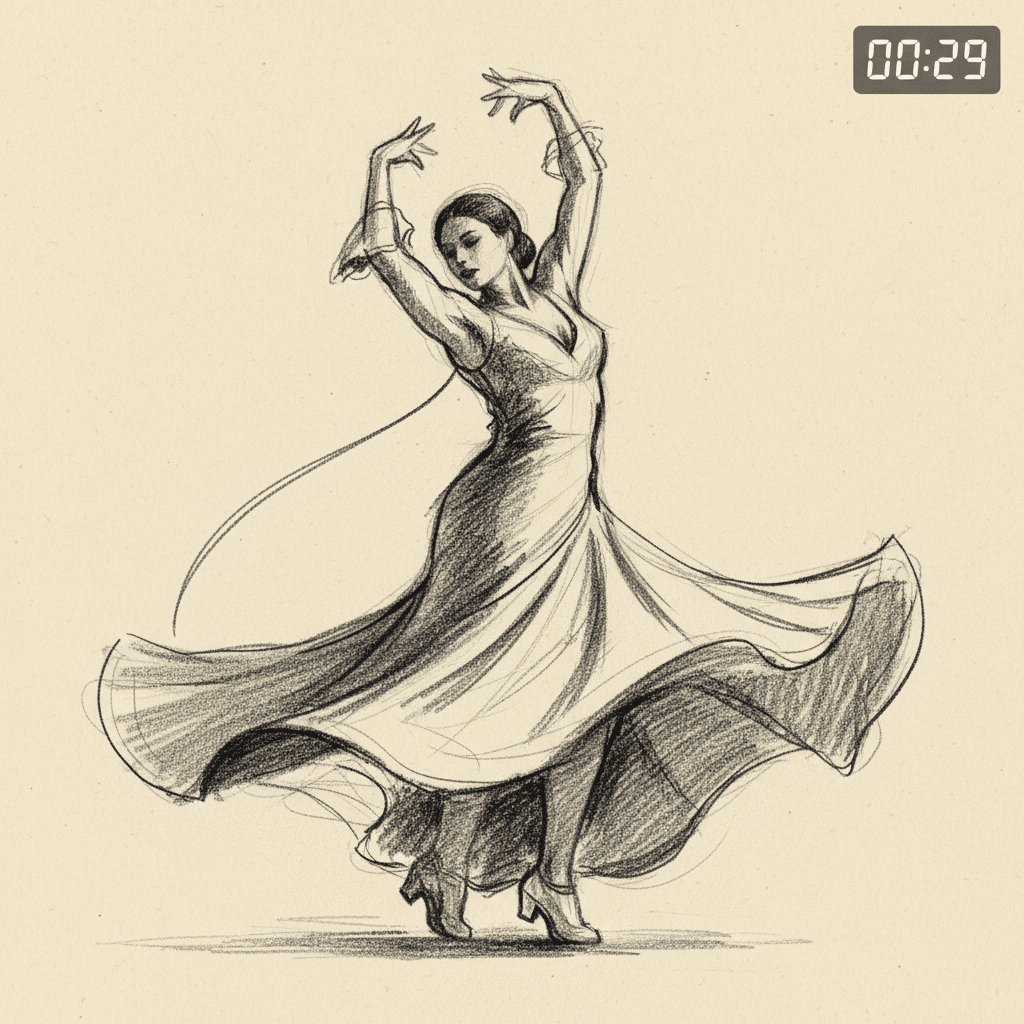
So, you’ve got your paper and pencil, and the timer is counting down. What exactly should you be focusing on in those precious 30 seconds? It’s not about rendering; it’s about feeling.
- Focus on Flow and Energy (The Primary Goal): This is the absolute cornerstone of gesture drawing. Your aim is to capture the feeling of the pose, its inherent dynamism. Is the figure reaching, bending, twisting, collapsing? Let your lines communicate that energy. Think of it as drawing the wind that moves through the figure. Don’t think of it as drawing individual parts.
- The Line of Action: This is arguably the most critical element. The line of action is an imaginary curve or series of curves that defines the main thrust or movement of the pose. It’s the “spine” of your drawing, giving it life and fluidity. For example, a standing figure might have a subtle S-curve running from the head down through the torso and into the weight-bearing leg. Start by finding and drawing this line first, often from head to toe or across the entire pose.
- Big Shapes First: Resist the urge to draw fingers, facial features, or clothing folds. Instead, block in the largest, most fundamental shapes of the body. Think of the torso as a big beanbag, the hips as a bowl, and the limbs as cylinders or tapered forms. These foundational shapes establish the overall proportion and placement without getting lost in minutiae.
- Rhythm and Movement: Observe how different parts of the body connect and flow into one another. A bent arm might lead into a twisted torso, which then transitions into a weight-bearing leg. Look for repeating curves, opposing forces, and the visual melody of the pose. This is where your drawing begins to sing.
- Weight and Balance: Every pose, even a dynamic one, has a sense of gravity and balance. Identify which parts of the body are supporting weight, and how that weight is distributed. A leaning figure will have a different balance than one standing tall. This understanding helps ground your figure and gives it believability.
- Exaggeration (Your Secret Weapon): Don’t be afraid to exaggerate the pose slightly to emphasize its core gesture. If an arm is reaching dynamically, make that reach even more pronounced. If a spine is curving, make that curve a little stronger. Exaggeration, used wisely, can amplify the energy and expressive quality of your drawing.
Techniques to Turbocharge Your 30-Second Sessions
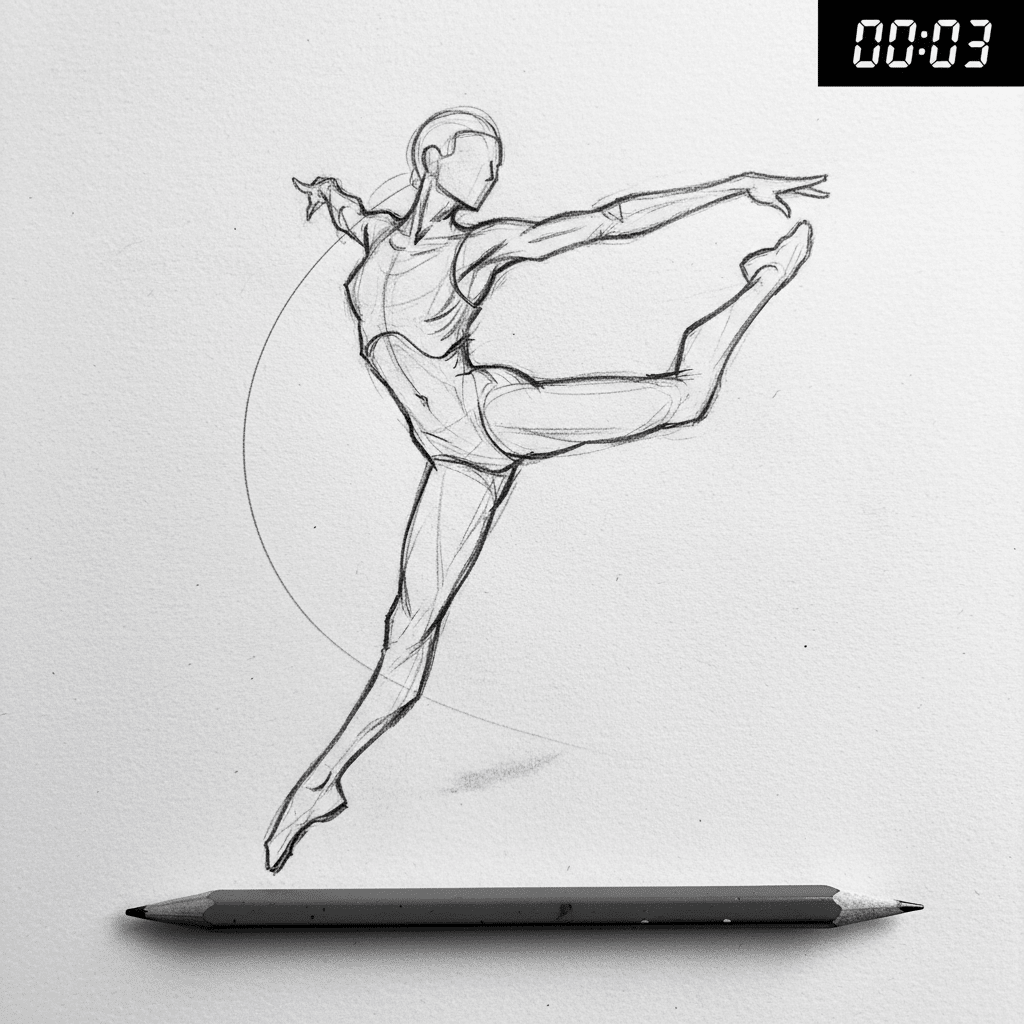
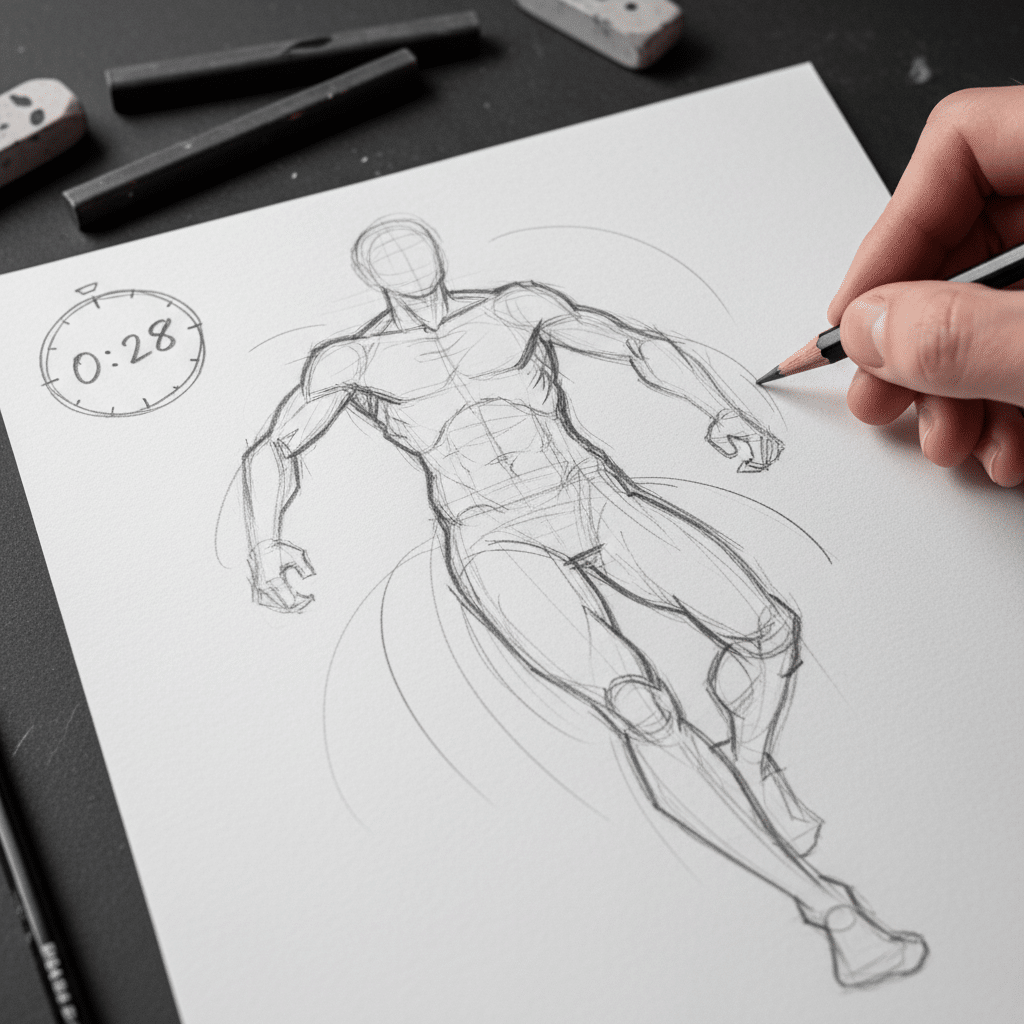
To really make the most of those fleeting moments, adopt a few key techniques that foster speed and intuition.
- Continuous Line Drawing: Try keeping your drawing tool on the paper from start to finish for the entire 30 seconds. This forces you to connect forms, maintain flow, and think ahead. You’re not lifting your pencil to “start a new line,” you’re constantly finding the next connection. This technique is fantastic for building confidence and improving hand-eye coordination.
- C-curves and S-curves: The human body is full of beautiful, organic curves. Actively look for C-curves (like the arch of a back) and S-curves (like the subtle curve of a torso or the line from a shoulder to a hip). These natural rhythms are the building blocks of dynamic poses and will make your gestures feel more alive.
- Weight Distribution (Revisited): As soon as you identify the line of action, quickly assess where the weight of the figure is resting. Is it on one leg? Both? Leaning forward? This understanding helps you ground the figure and prevent it from looking like it’s floating. You might quickly draw a small mark or line to indicate the ground plane under the weight-bearing foot.
- Negative Space: Don’t just focus on the figure itself. Look at the shapes created by the space around the figure. These “negative spaces” can often be easier to see and draw accurately, which in turn helps you define the positive shape of the figure more precisely. For instance, the space between an arm and the torso can tell you a lot about the arm’s position.
- Squinting: This simple trick is incredibly powerful. When you squint your eyes, you blur details and reduce the visual information to its most essential forms and values. It helps you see the big shapes, the overall silhouette, and the primary lines of action, making it easier to prioritize in a quick gesture.
- Drawing from the Shoulder/Elbow: Avoid drawing just from your wrist and fingers, especially with quick gestures. Engage your entire arm. Drawing from your shoulder or elbow allows for much larger, more fluid, and more expressive lines. It takes practice to loosen up, but the results are worth it. Imagine you’re painting with a big brush, not writing with a pen.
Common Pitfalls and How to Dodge Them
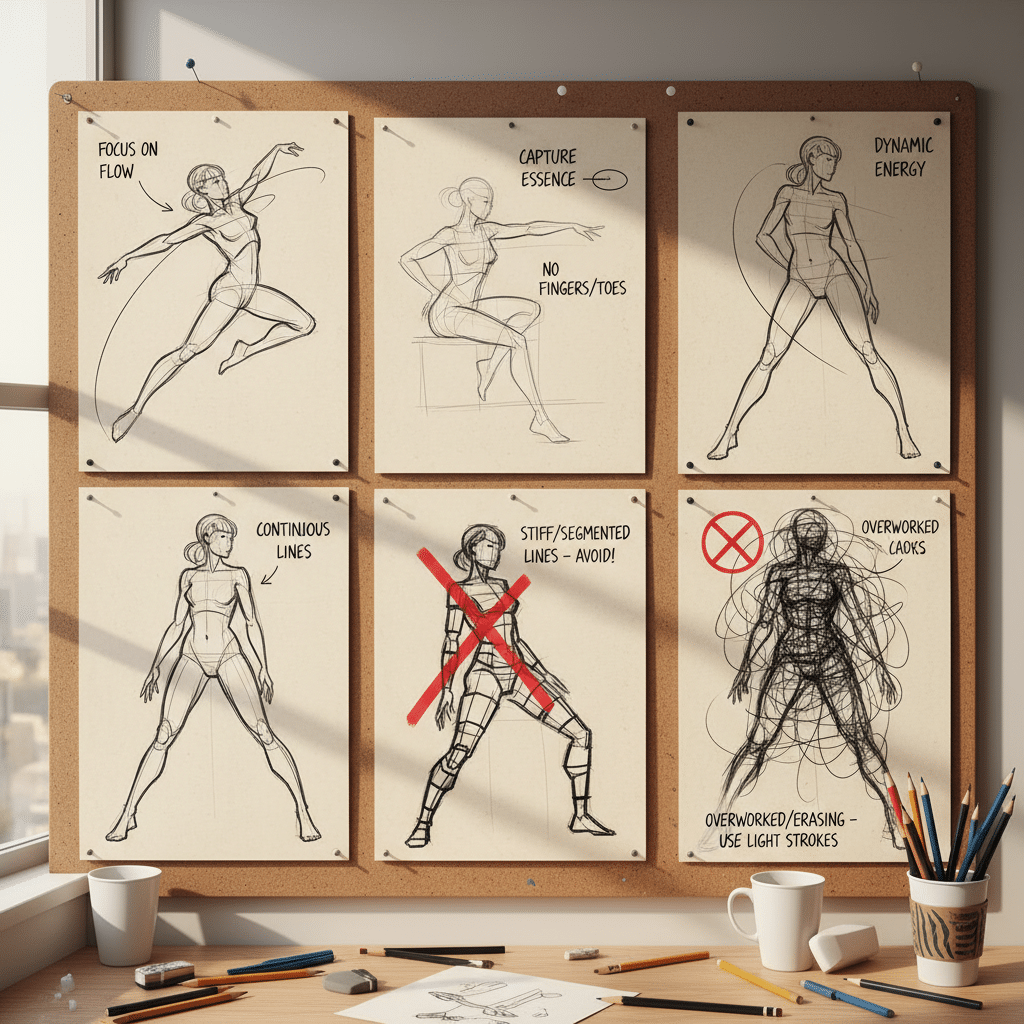

Even with the best intentions, it’s easy to fall into traps when you’re starting with 30 second gesture drawing. Being aware of these common pitfalls can help you steer clear and maximize your learning.
- Getting Bogged Down in Detail: This is by far the biggest challenge. Your brain naturally wants to identify and draw what it recognizes – eyes, fingers, hair. But in 30 seconds, these details are irrelevant. The moment you start rendering a face, the timer is gone, and you’ve missed the gesture. How to dodge: Continuously remind yourself: “Energy, not accuracy. Flow, not features.” If you catch yourself detailing, immediately pull back and focus on the largest forms.
- Stiff, Static Poses: If your figures look like rigid mannequins rather than dynamic beings, you might be missing the “gesture.” You’re drawing parts rather than the overall movement. How to dodge: Always start with the line of action. Think of your lines as pathways for energy. Look for curves and diagonals, not just vertical and horizontal lines. Exaggerate the movement a little!
- Obsessing Over Accuracy: Gesture drawing is not about creating a perfectly proportioned, anatomically correct figure. It’s about communication and speed. If you’re constantly judging your drawings as “bad” because they don’t look exactly like the reference, you’re missing the point. How to dodge: Shift your mindset. See each drawing as an exercise, a practice run. The goal isn’t a portfolio piece; it’s a learning experience. Embrace the wonky, the imperfect, the expressive.
- Fear of “Bad” Drawings: This ties into the previous point. Many artists fear making “bad” art. But in gesture drawing, a “bad” drawing is often a sign you’re pushing boundaries and learning. How to dodge: Fill pages with rapid, messy lines. Don’t pause to critique each one. Move immediately to the next. The sheer volume of practice will lead to breakthroughs. Remember, you’re training your eye and hand, not creating a finished product.
- Not Practicing Consistently: Like any skill, artistic development requires repetition. A few 30-second gestures here and there won’t build the muscle memory you need. How to dodge: Dedicate specific, short blocks of time each day or a few times a week. Even 15-20 minutes of focused 30-second gestures can make a huge difference over time. Treat it like a daily exercise for your artistic brain and hand, much like you might commit to draw your day: creating a visual diary for documenting your experiences.
Integrating Gesture Drawing into Your Daily Routine

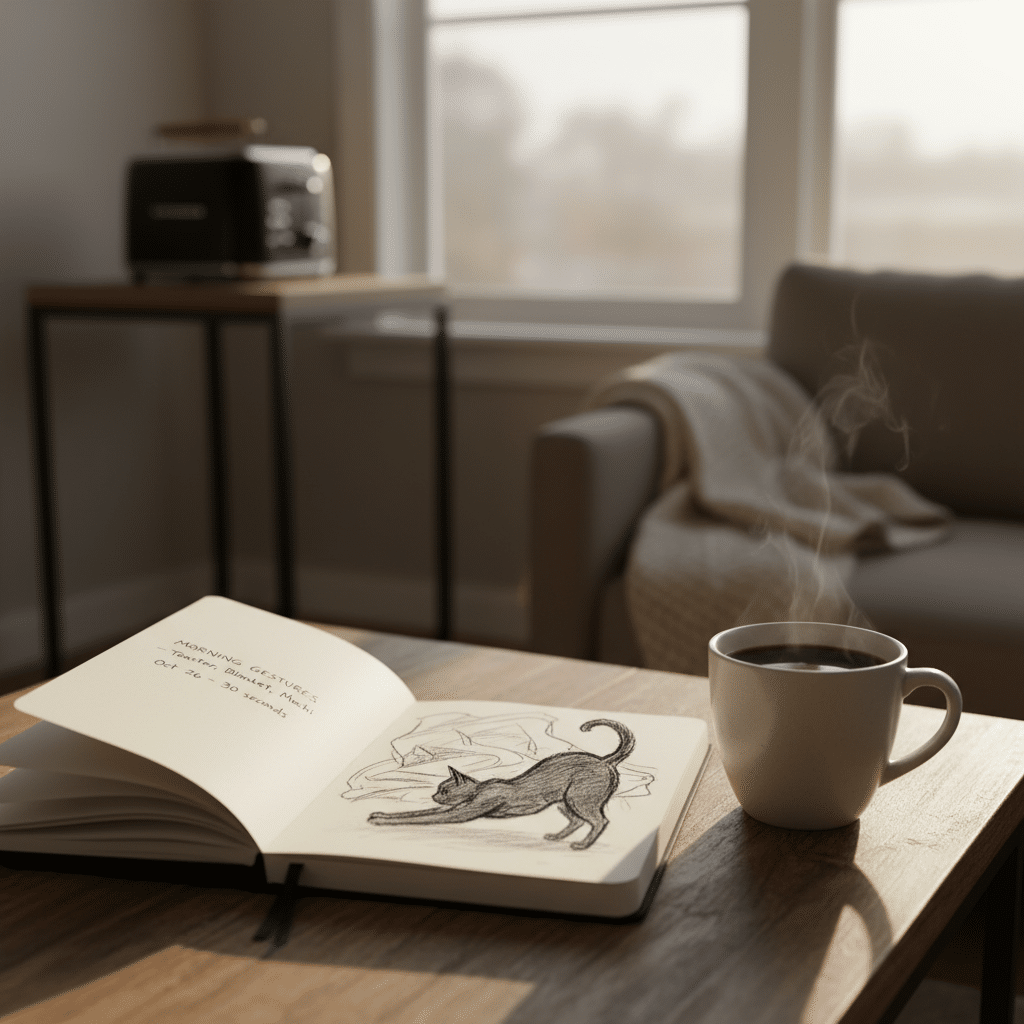
The beauty of 30 second gesture drawing is its adaptability. You don’t need a dedicated studio or hours of free time. You can weave it into your everyday life with surprising ease.
- Short Bursts Throughout the Day: Got a 10-minute break between meetings? Waiting for your coffee to brew? These are prime opportunities for a quick gesture session. Pull up an online timer, grab your notepad, and go. Even 5 minutes of focused practice is better than none.
- Using Apps and Websites: As mentioned, online platforms are your best friends here. They provide an endless supply of varied poses and handle the timing for you. Bookmark your favorites and make them easily accessible.
- Drawing People in Public (Discreetly!): This is where it gets fun and challenging. Next time you’re at a coffee shop, a park, or on public transport, subtly observe people. Try to capture their posture, their weight distribution, and the general feeling of their pose in your mind, then quickly sketch it on your pad. Don’t stare, just observe and draw. This is an excellent way to practice “sketching on the go” and developing a keen eye for human forms in natural settings, just like you might for sketching on the go: tips for travel memories.
- Pairing it with Other Art Practices: Use gesture drawing as your warm-up for longer sessions. Before you tackle a detailed portrait or a complex still life, do 10-15 minutes of quick gestures. It will loosen you up, sharpen your observation, and improve the flow of your subsequent work. It’s a fundamental step before moving onto more advanced techniques like shading techniques that require a solid understanding of form.
Beyond the 30 Seconds: How Gesture Drawing Elevates Your Overall Art
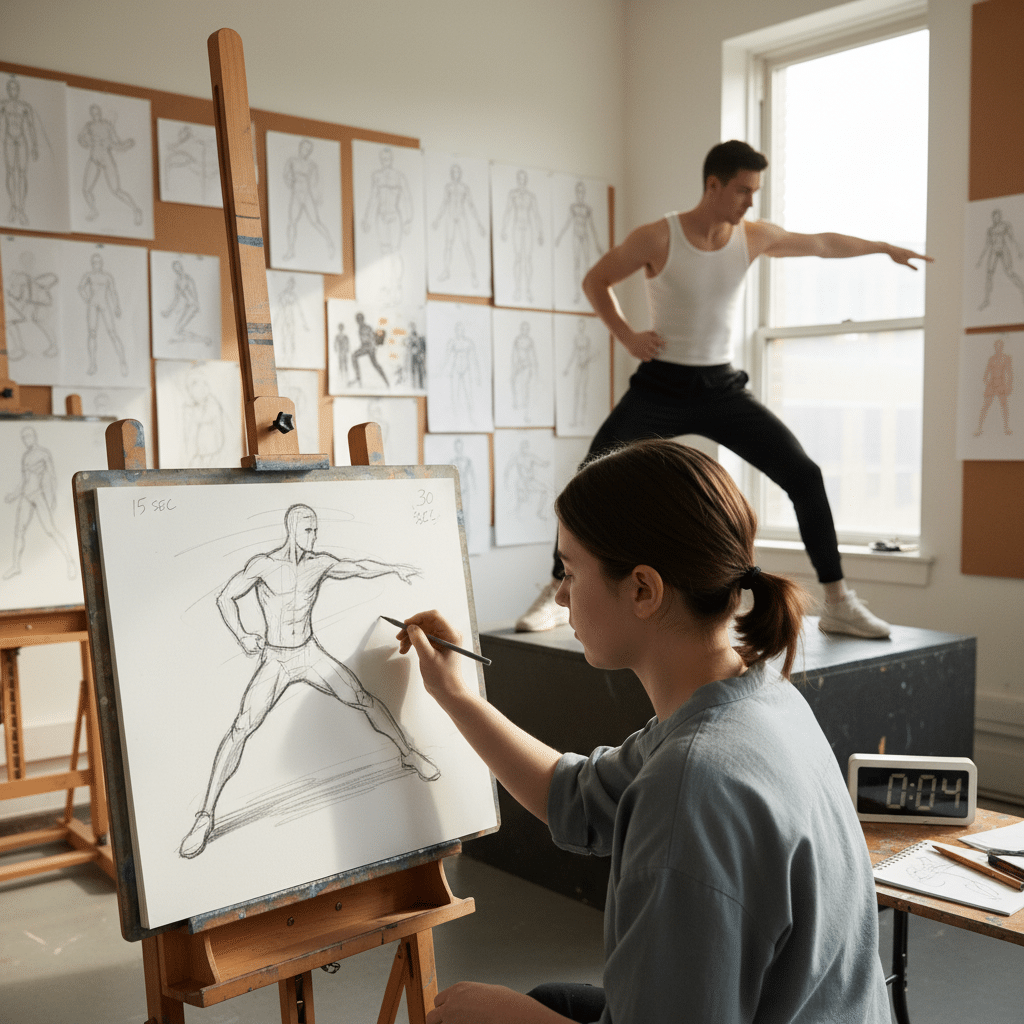
While 30 second gesture drawing is a powerful practice in itself, its true magic lies in how it ripples out and positively impacts every other aspect of your artistic journey.
First and foremost, your improved observational skills will become evident across all subjects. Whether you’re drawing landscapes, still life, or abstract compositions, you’ll find yourself more adept at seeing the essential forms, the underlying structure, and the overall rhythm of your subject. You’ll intuitively look for the “gesture” in everything.
You’ll develop a much better understanding of form and structure that translates seamlessly into longer, more detailed drawings. Having built a strong intuitive grasp of proportion, balance, and how forms connect, you’ll approach extended poses with a foundational confidence. Your figures will feel more solid, dynamic, and believable, even when you start adding anatomical details. This applies to specialized fields like fashion design drawings, where understanding the figure’s movement and drape is paramount.
Gesture drawing also fosters enhanced creativity and problem-solving. The rapid nature of the exercise trains your brain to think quickly and find solutions under pressure. This mental agility is invaluable when you encounter artistic challenges in any medium. You’ll become less afraid to experiment and more confident in trusting your instincts.
Finally, and perhaps most profoundly, gesture drawing leads to greater confidence and decisiveness in your lines. You’ll shed the hesitant, scratchy lines of an uncertain hand and replace them with bold, expressive strokes. This confidence isn’t just about technique; it’s about a deeper self-assurance in your artistic vision. You learn to commit, to trust your eye, and to let your hand dance across the page with purpose.
Conclusion
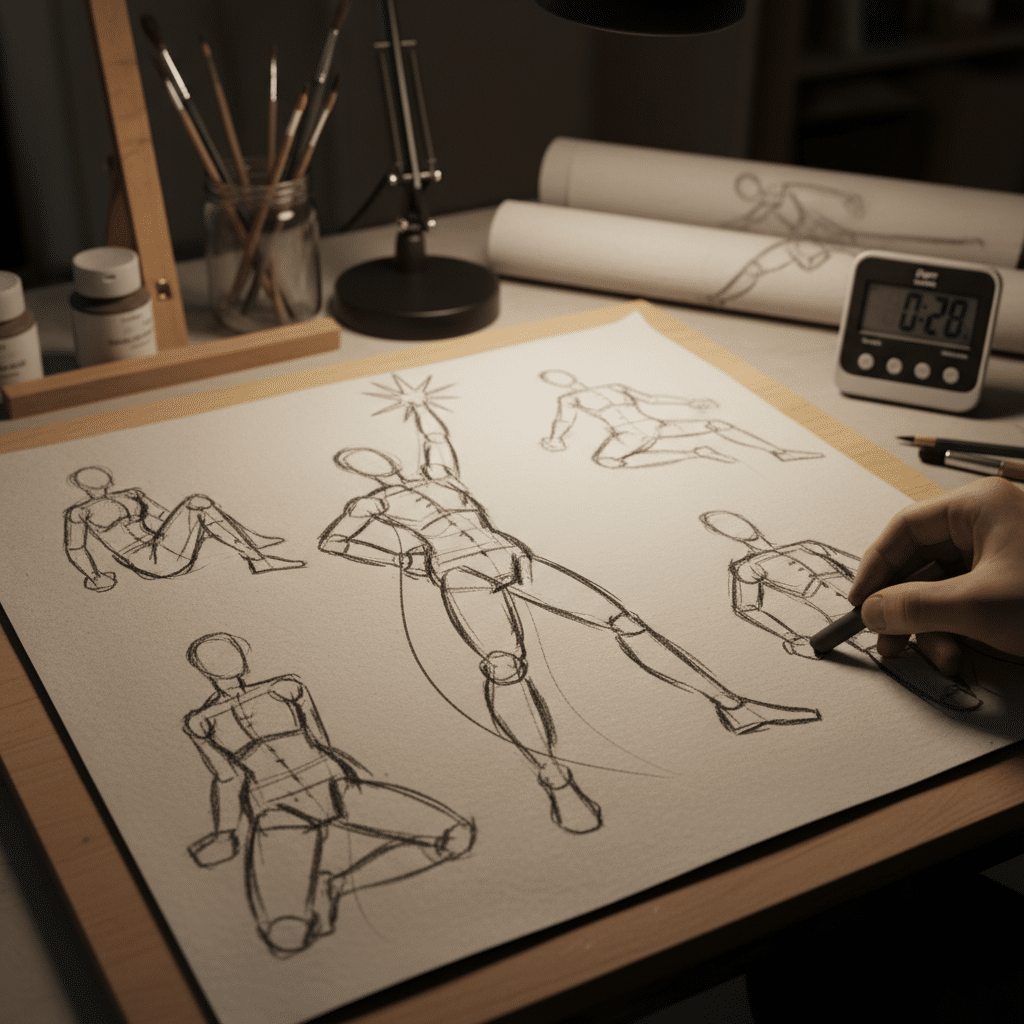
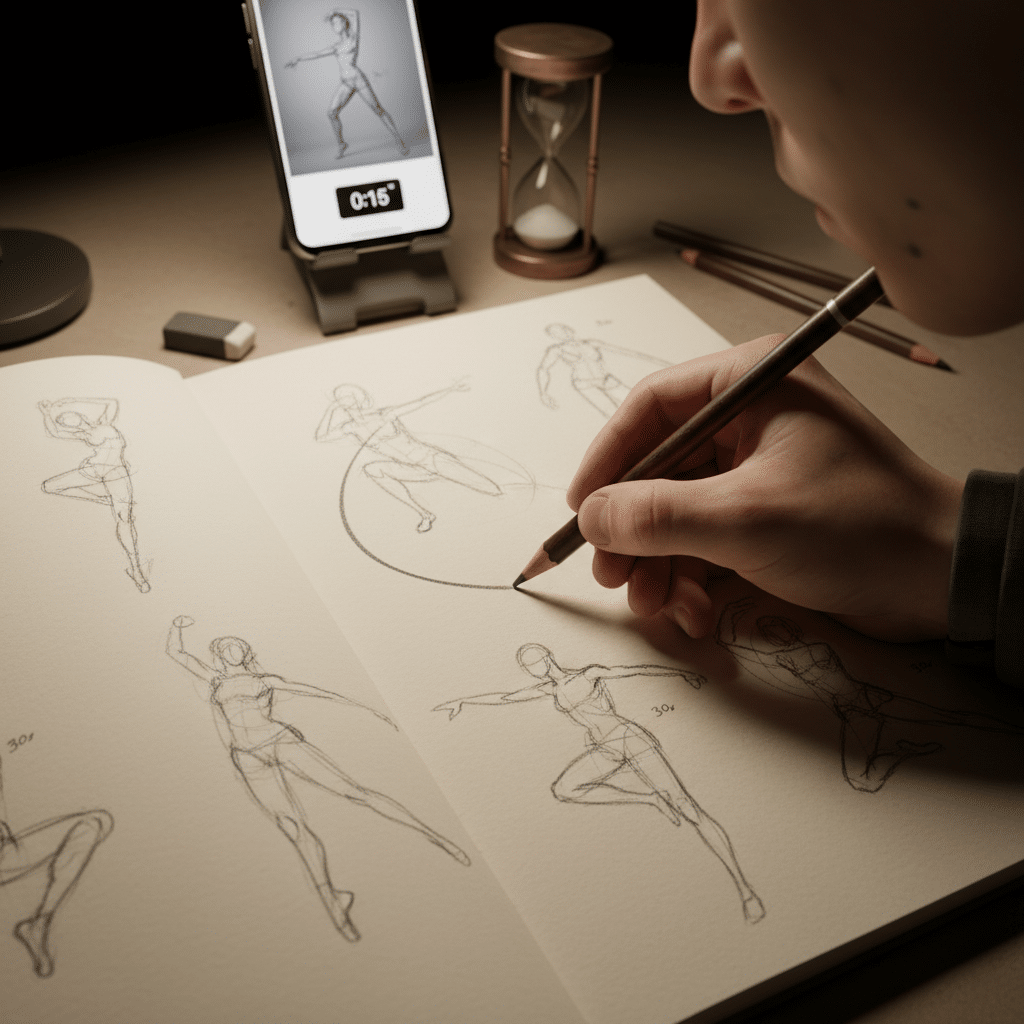
So there you have it. 30 second gesture drawing isn’t just a fleeting exercise; it’s a gateway to unlocking your true artistic potential. It’s a practice that celebrates movement, embraces imperfection, and relentlessly sharpens your eye and hand. From developing lightning-fast observational skills to instilling a profound confidence in your lines, the benefits are truly transformative.
Forget the pressure of perfection. Embrace the joy of expression. Grab your simplest tools, set that timer, and dive into the exhilarating world of quick gestures. You’ll be amazed at the artistic flow you’ll unlock, the skills you’ll build, and the sheer delight you’ll find in the process. Your journey to more dynamic, expressive, and confident art starts now. What are you waiting for? Grab your tools and start drawing!
- 43shares
- Facebook0
- Pinterest43
- Twitter0


